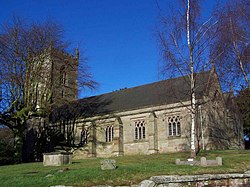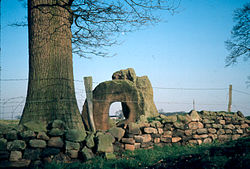Mucklestone: Difference between revisions
Created page with "{{infobox town |county=Stafford |picture=St Mary, Mucklestone (geograph 1684939).jpg |picture caption=St Mary's |LG district=Newcastle-under-Lyme |constituency=Stone |post tow..." |
m →top: clean up, replaced: medieval → mediæval |
||
| Line 21: | Line 21: | ||
Mucklestone township contains about 1,100 acres. Aston, a village and township, three and a half miles north-east of Mucklestone, and eight miles south-west of [[Newcastle-under-Lyme]], contains 912 acres. Knighton is a small township, a mile south-west of Aston, bounded on three sides by Shropshire. Oakley township at the south end of the parish, two miles south-west of Mucklestone, contains Oakley Hall, in a beautiful park of 300 acres, on the east bank of the [[River Tern]], which locally divides Staffordshire from Shropshire. Winnington township, has a small village a mile north of Mucklestone.<ref>William White, ''History, Gazetteer and Directory of Staffordshire'', Sheffield, 1851.</ref> | Mucklestone township contains about 1,100 acres. Aston, a village and township, three and a half miles north-east of Mucklestone, and eight miles south-west of [[Newcastle-under-Lyme]], contains 912 acres. Knighton is a small township, a mile south-west of Aston, bounded on three sides by Shropshire. Oakley township at the south end of the parish, two miles south-west of Mucklestone, contains Oakley Hall, in a beautiful park of 300 acres, on the east bank of the [[River Tern]], which locally divides Staffordshire from Shropshire. Winnington township, has a small village a mile north of Mucklestone.<ref>William White, ''History, Gazetteer and Directory of Staffordshire'', Sheffield, 1851.</ref> | ||
The church of Saint Mary at Mucklestone, which originally served the whole of the ancient parish, is in the decorated style. Except for the tower, it was rebuilt according to church records in 1789 and again in 1883 by Lynam and Rickman in keeping with the surviving | The church of Saint Mary at Mucklestone, which originally served the whole of the ancient parish, is in the decorated style. Except for the tower, it was rebuilt according to church records in 1789 and again in 1883 by Lynam and Rickman in keeping with the surviving mediæval tower.<ref>{{cite book |title=Staffordshire (Pevsner Buildings of England) |first=Nikolaus |last=Pevsner |publisher=Yale University Press / Penguin Books |year=1974 |pages=207 |isbn=0-14-071046-9}}</ref> It contains stained-glass windows, designed by Charles Kempe in the 19th century including commemorations of the Battle of Blore Heath. | ||
Other local structures of merit include a Georgian Folly; an important house of earlier date known as Willoughbridge Lodge; warm springs (discovered in the 17th century) and known, together with the ruined bath house c1682, as Willoughbridge wells; and also Oakley Hall built about 1710.<ref>{{cite book |title=Staffordshire (Pevsner Buildings of England) |first=Nikolaus |last=Pevsner |publisher=Yale University Press / Penguin Books |year=1974 |pages=214 |isbn=0-14-071046-9}}</ref> | Other local structures of merit include a Georgian Folly; an important house of earlier date known as Willoughbridge Lodge; warm springs (discovered in the 17th century) and known, together with the ruined bath house c1682, as Willoughbridge wells; and also Oakley Hall built about 1710.<ref>{{cite book |title=Staffordshire (Pevsner Buildings of England) |first=Nikolaus |last=Pevsner |publisher=Yale University Press / Penguin Books |year=1974 |pages=214 |isbn=0-14-071046-9}}</ref> | ||
Latest revision as of 10:59, 30 January 2021
| Mucklestone | |
| Staffordshire | |
|---|---|
 St Mary's | |
| Location | |
| Grid reference: | SJ725375 |
| Location: | 52°56’3"N, 2°24’38"W |
| Data | |
| Post town: | Market Drayton |
| Postcode: | TF9 |
| Dialling code: | 01630 |
| Local Government | |
| Council: | Newcastle-under-Lyme |
| Parliamentary constituency: |
Stone |

Mucklestone is a small village and ancient parish in Staffordshire. The village is about nine miles north-west of Eccleshall, and four and a half miles north-east of Market Drayton in Shropshire. The ancient parish extends over the border into the latter county.
It is notable for its associations with the Battle of Blore Heath. According to legend, Queen Margaret of Anjou is said to have watched the defeat of her forces from the church tower, before fleeing on horse-back.[1] It is said that Margaret employed the local blacksmith, William Skelhorn, to reverse the shoes on her horse to disguise her getaway. An anvil said to have belonged to Skelhorn stands in the churchyard to commemorate the event.
The ancient parish of Mucklestone comprises nine townships. Five of them: Aston, Knighton, Mucklestone, Oakley and Winnington are in Staffordshire and the other four: Bearstone, Dorrington, Gravenhunger and Woore, are in Shropshire.
Mucklestone township contains about 1,100 acres. Aston, a village and township, three and a half miles north-east of Mucklestone, and eight miles south-west of Newcastle-under-Lyme, contains 912 acres. Knighton is a small township, a mile south-west of Aston, bounded on three sides by Shropshire. Oakley township at the south end of the parish, two miles south-west of Mucklestone, contains Oakley Hall, in a beautiful park of 300 acres, on the east bank of the River Tern, which locally divides Staffordshire from Shropshire. Winnington township, has a small village a mile north of Mucklestone.[2]
The church of Saint Mary at Mucklestone, which originally served the whole of the ancient parish, is in the decorated style. Except for the tower, it was rebuilt according to church records in 1789 and again in 1883 by Lynam and Rickman in keeping with the surviving mediæval tower.[3] It contains stained-glass windows, designed by Charles Kempe in the 19th century including commemorations of the Battle of Blore Heath.
Other local structures of merit include a Georgian Folly; an important house of earlier date known as Willoughbridge Lodge; warm springs (discovered in the 17th century) and known, together with the ruined bath house c1682, as Willoughbridge wells; and also Oakley Hall built about 1710.[4]
In the hedgerow of the field beside the footpath along the western perimeter of the great park of Oakley Hall at Mucklestone is a neolithic monument, possibly the remains of a burial-mound.[5] It comprises two big stones, one round with a 20-inch-diameter hole in the middle and the other, at six foot, tall and slender. They are known locally as the "devil's ring and finger".
References
- ↑ Mee, Arthur (1971). Staffordshire (King's England). Hodder & Straughton. pp. 132. ISBN 0-340-15030-0.
- ↑ William White, History, Gazetteer and Directory of Staffordshire, Sheffield, 1851.
- ↑ Pevsner, Nikolaus (1974). Staffordshire (Pevsner Buildings of England). Yale University Press / Penguin Books. pp. 207. ISBN 0-14-071046-9.
- ↑ Pevsner, Nikolaus (1974). Staffordshire (Pevsner Buildings of England). Yale University Press / Penguin Books. pp. 214. ISBN 0-14-071046-9.
- ↑ Palliser, D. M.,The Staffordshire Landscape,Hodder and Stoughton,1976,ISBN 0-340-12994-8
Outside links
| ("Wikimedia Commons" has material about Mucklestone) |
The village school (linked to Church) in former orchard
